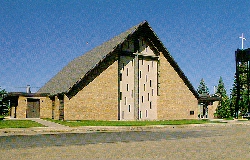

Tucked into the northwest corner of St. Peter's Colony, the chick farthest away from the mother hen, is St. Michael's Parish of Cudworth.
Our parish borders on the Diocese of Saskatoon to the west and Prince Albert to the north. Because of our nearness to these neighboring dioceses, St. Michael's serves people from three distinctively different dioceses, and we share in many ways with our Ukrainian Catholic friends as well.
We are fortunate to have a Ukrainian rite Catholic sister parish called Holy Eucharist. Over the years, the friendship between the two parishes has served us in good stead. When our church was demolished but not yet rebuilt, when we renovated and could not use our church, our masses were celebrated at Holy Eucharist. When their church burnt or when they were without a priest, the parishioners from Holy Eucharist were welcomed at St. Michael's. It helps knit our community into one large group of friends.
There is also a Ukrainian Greek Orthodox church in Cudworth. When they have a fall supper you will find many Catholics enjoying the borscht, cabbage rolls and perogies.
Organized religion started many years ago when Fr. Meinrad Seifermann offered the first mass about a mile southeast of Cudworth.
A small chapel was built there and used until the church of St. Boniface at Leofeld was ready. For many years the spot of the first mass was marked with a large wooden cross bearing the inscription "The Gateway to St. Peter's Colony, 1903."
To replace the cross which had rotted, Fr. Roman Schneider, OSB, pastor, and members of the Schneider family, initiated the "Gateway Project." They obtained a small parcel of land and at their own expense built a beautiful and imposing stone cairn on the location. There is a chain link fence around the area which has been seeded to grass.
A plaque cemented to the cairn reads: "Saskatchewan History and Folklore Society. Gateway to St. Peter's Colony. In 1902 Fr. Bruno Doerfler from St. John's Abbey, Minn., with others, searched the then North West Territories for a suitable agricultural land base for a German Catholic settlement. This is the site where they entered the present St. Peter's Colony. In the years following many pioneers entered here via Rosthern. A chapel was built here and the first holy mass was celebrated May 17, 1903. A store and hostel was also built for the pioneers.
In 1911 the Canadian National Railroad was completed through Cudworth and the village was incorporated. The railway was the anchor around which business centralized. Cudworth flourished and Leofeld began its decline. The steady pull of the Catholic community to satisfy its religious needs culminated in forming St. Michael's Parish in September 1924 with Fr. Casimir Cismowski, OSB. as pastor.
The year 1924 was not the beginning of Catholic services in Cudworth. The village was a mission under St. Boniface, Leofeld, and had monthly masses dating from Dec. 8, 1912. After the death of Fr. Stephen Mohorko, OSB, in 1968, St. Boniface was closed and its members joined St. Michael's Parish.
Like many other parishes, St. Michael's has had its growing pains. The first came six years after the construction of the first church. By 1930 the parish had outgrown the church and so it had to be enlarged. In 1952 the basement of this church was enlarged and refurbished. We were very fortunate in never suffering a loss by fire.
In the late '60s, under the leadership of Fr. Alfred Engele, OSB, it was decided to build a new church. The old St. Michael's was taken down for salvage in the spring of 1968. The boards live on in several homes around the area.
Construction on the new church began in August 1968. The contractor was Donald Loeffelholz and the architect B.T. Arling. One year and a month later the new church was ready for use. The parishioners are very proud of the fact that no debt was incurred.
Along with the evolution of the church plant goes the story of the bells. In 1920 a parishioner donated a 700 pound bell which was blessed by Abbot Michael Ott, OSB, on May 8, 1921, and given the name St. John. However, St. John cracked in 1928 and could not be rung for Christmas that year. St. John was replaced by Sts. Michael and Maria. They were blessed by Abbot Severin Gertken, OSB, in July 1929. The larger bell carries the inscription "St. Michael's Port to St. Peter's Colony." These bells rang out daily for many years but after the first church was taken down, they lay silent on the church lawn for several years, while children played on them.
In 1982, after the construction of the new church, a tower was put up (contractor: Hubert Lux of Humboldt) to support Michael and Maria. But now they are not free swinging bells. They do, however, announce the beginning of the mass with enthusiasm but not with quite as much melody. The stationary bells are struck by hammers electrically controlled from within the sacristy.
As parishioners, we have reason to be very proud of some pieces of art in our church. Dominating the wall behind the altar is a very large and beautiful crucifix. The five foot tall corpus was hand carved in Oberammergau, Germany, and donated to St. Michael's by Dr. Jerome Schropp. The cross that supports this corpus is solid walnut from Iowa and was finished by waxing. It, and the rays, were designed, constructed and donated by Donald Loeffelholz.
The altar front piece was carved and donated to St. Michael's by Dr. Zigmund Kondzielewski. John (Hans) Saxinger built the modern altar which contains this carving.
[ Home ]
Please send comments to Carlton Trail REDA Inc.
Box 10, Muenster, Sk., S0K 2Y0![]()
[ The Humboldt Journal ][Early Humboldt]
[ St. Peter's Abbey | Agriculture | Communities ]
[ Present-day Humboldt and Surrounding Communities ]
[ Language ]
![]()